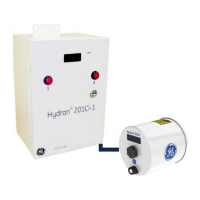13.1.1 Battery L
• Alarm type: Fail alarm
• Non-abbreviated description: Battery voltage Low
• Priority: Very low
• Parameter(s) involved:
- Batt. L; SysOK Relay; FaultTrig. submenu; Section 5.5.7.
- Batt.Alr L (alarm set point); Service; VoltPile submenu; Section 5.5.4.3.
- BattAlr Delay; Service; VoltPile submenu; Section 5.5.4.3.
• Alarm cause(s): Battery voltage below the Batt.Alr L alarm set point
Replace the battery within the next nine months. For details, see Section 3.7.3.
13.1.2 Battery LL
• Alarm type: Fail alarm
• Non-abbreviated description: Battery voltage Low-Low
• Priority: Low
• Parameter(s) involved:
- Batt. LL; SysOK Relay; FaultTrig. submenu; Section 5.5.7.
- Batt.Alr LL (alarm set point); Service; VoltPile submenu; Section 5.5.4.3.
- BattAlr Delay; Service; VoltPile submenu; Section 5.5.4.3.
• Alarm cause(s): Battery voltage below the Batt.Alr LL alarm set point
Replace the battery within the next three months. For details, see Section 3.7.3.
13.1.3 CableOpen
• Alarm type: Fail alarm
• Non-abbreviated description: Cable open (not connected)
• Priority: Very high (repair cable immediately)
• Parameter(s) involved:
- CableOpen; SysOK Relay; FaultTrig. submenu; Section 5.5.7.
- No set point nor delay
• Alarm cause(s): Faulty connection with one of the following cables:
- Hydran 201 sensor cable
- Sensor thermistor cable (reading of -75°C [-103°F] during one minute)
- Heating plate thermistor cable (reading of -75°C [-103°F] during one
minute)
Proceed as follows:
1. Identify the cable that triggers the alarm.
• Verify whether the SensorTemp value in the Temperature submenu displays -
75°C (-103°F). If so, the sensor thermistor cable (or a connector in the chain of
connections) is the one causing the alarm.

